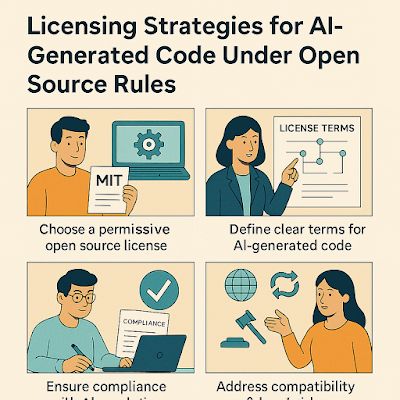Licensing Strategies for AI-Generated Code Under Open Source Rules
Licensing Strategies for AI-Generated Code Under Open Source Rules
📘 Table of Contents
- Understanding AI-Generated Code
- Open Source License Types That Matter
- Compliance Risks for Companies
- Dealing with Copyleft and Derivative Works
- Best Practices for Mitigating Legal Risk
🤖 Understanding AI-Generated Code
AI tools like GitHub Copilot, ChatGPT, and others are now used to produce substantial portions of source code across industries.
But who owns the code? And what happens when it includes or resembles open source content?
Determining authorship and licensing of AI-generated output is an evolving legal frontier.
📄 Open Source License Types That Matter
Common open source licenses include permissive (MIT, Apache 2.0) and copyleft (GPL, AGPL).
Permissive licenses allow reuse with minimal restrictions, while copyleft licenses may require derivative works to also be open source.
AI-generated code that resembles or reproduces open source code can inherit these obligations.
It's vital to track provenance and use license-aware generation systems when possible.
⚠️ Compliance Risks for Companies
Distributing AI-generated software without license review may expose companies to IP litigation or license breaches.
This is especially true if generated code contains fragments of GPL-covered content without proper attribution or disclosure.
Risk assessments and automated license scanners should be part of any CI/CD pipeline.
🔗 Dealing with Copyleft and Derivative Works
Some courts may treat AI-generated code as derivative if it closely mirrors copyrighted material.
To avoid triggering GPL obligations, developers should segregate open source code from proprietary repositories.
Alternatively, commercial open source licenses (like dual licensing) may offer structured paths to compliance.
✅ Best Practices for Mitigating Legal Risk
1. Train developers on open source compliance basics
2. Use code generation tools that track source provenance
3. Review outputs for license flags using scanners like FOSSA or WhiteSource
4. Maintain clean room development practices when necessary
5. Consult IP counsel when integrating AI-generated code in commercial products
🔗 Further Reading
Learn more from trusted legal-tech and compliance sources:
Keywords: AI code licensing, open source compliance, copyleft risk, GPL enforcement, legal risk mitigation
